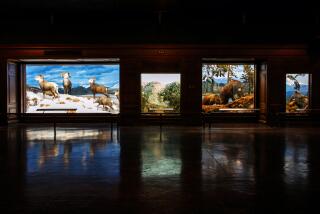Exhibit Reflects the Kaleidoscope’s Enduring Popularity : Science: The Fullerton Museum Center show offers a hands-on introduction to the principles involved in this 19th-Century invention. Some of the devices have a modern twist.
- Share via
FULLERTON — Hunter Crosby stood three small mirrors on edge, shifted one ever so slightly, then peered at the objects framed inside. Straightening, the young researcher gave his appraisal. “Totally cool,” he said, a satisfied grin spreading across his face.
Hunter, 10, had “discovered” the kaleidoscope.
“Kaleidoscopes: Reflections of Science and Art” at the Fullerton Museum Center, offers a kid-friendly introduction to the scientific principles of the kaleidoscope through 14 interactive learning stations. The exhibit, which also includes a display of antique and contemporary kaleidoscopes, continues through Aug. 26.
But “Kaleidoscopes,” which is sponsored by the Smithsonian Institution Traveling Exhibition Services and the Willamette Science and Technology Center of Oregon, has a broad appeal. For budding mathematicians, the hands-on stations offer detailed explanations of symmetry and asymmetry, polarization and the geometric forms icosahedron and tetrahedron. At each stop, visitors can discover something about these and other principles using a variety of tools.
Or, like Hunter, who confesses he only “sort of understands math,” visitors can take a less cerebral approach.
“I just think it’s neat how all the different colors and shapes change,” said the Anaheim grade-schooler as he assembled a four-sided mirror box. “It’s taught
me how you can change the look of a lot of things in life.”
Hunter’s enthusiasm was shared by Sir David Brewster (1781-1868), the 19th-Century Scottish scientist who created the first hand-held kaleidoscope. Although experiments in reflection had been documented as early as 1558, it was Brewster’s optical toy that enchanted both the scientific community and the general public. Its popularity spread through London like wildfire, and it quickly became a fixture in nearly every Victorian parlor in London. In one three-month period, an estimated 200,000 kaleidoscopes were sold in London and Paris alone.
In 1873, Charles August Busch, a Prussian immigrant to the United States, patented his version of the scope and produced vast numbers of them in factories in Rhode Island and New Hampshire until his death in 1899. (Two 19th-Century kaleidoscopes--one German and one American--are in the show.) And today, although Nintendo may be the parlor game of choice, there are still more than 100 American crafts people making kaleidoscopes in a wide variety of materials.
As the display explains, there are four basic elements in the typical kaleidoscope: the tube, the eyepiece, the reflective surfaces and the object case. Inside the tube are two or three reflective surfaces (often mirrors) capped at one end by the eyepiece and at the other by the object case, which commonly contains bits of colored glass. By pointing the tube toward light and twisting the object case, the viewer can create a seemingly endless array of brilliant patterns.
But there are almost as many variations in scope design as there are images created. As several of the display stations demonstrate, a kaleidoscope maker can alter the brightness and color with the use of different reflective materials. Wildly different patterns can be created by using a two-mirror scope rather than a three-mirror model. Polarized materials in the object case will produce intensely detailed images, and the use of Mylar as reflective strips will create distorted “pop-art” shapes.
Accompanying “Kaleidoscopes” is a display of seven contemporary models from the collection of the Eileen Kremen Gallery in Fullerton. Visitors can take a look through “Black Beauty,” a sleek little number that uses a pair of revolving discs of multicolored glass in place of a traditional object box. When both discs are spun in opposite directions, the effect is similar to an explosion on a Saturday morning cartoon, to create an explosive effect, with a series of vivid colors bursting before your eyes.
The “Chorus Line” model builds on this effect by adding small objects such as a tiny metal spider or a bit of gold filigree to its glass discs.
“Kaleidoscopes: Reflections of Science and Art” continues through Aug. 26 at the Fullerton Museum Center, 301 N. Pomona Ave., Fullerton. Museum hours are Tuesday, Wednesday, Saturday and Sunday from 11 a.m. to 4 p.m.; Thursday and Friday from 11 a.m. to 9 p.m. Admission: $1 to $2; free to children under 12 and to all visitors after 6 p.m. on Thursdays. Information: (714) 738-6545.
More to Read
The biggest entertainment stories
Get our big stories about Hollywood, film, television, music, arts, culture and more right in your inbox as soon as they publish.
You may occasionally receive promotional content from the Los Angeles Times.










